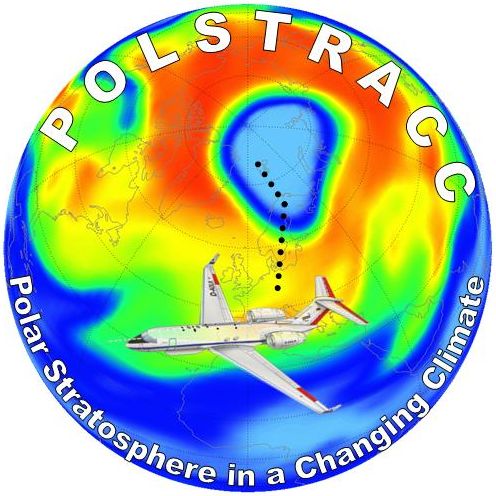Difference between revisions of "POLSTRACC"
| Line 1: | Line 1: | ||
| − | The polar stratosphere is of essential importance for the evolution of the global ozone layer and the |
+ | The polar stratosphere is of essential importance for the evolution of the global ozone layer and the climate in future. Catalytic ozone destruction in the Arctic winter vortex leads to a seasonal thinning of Arctic stratospheric ozone. Chemical processed air resulting from the outflow of the polar vortex and the dissipating polar vortex in Arctic spring enters the Upper Troposphere/Lower Stratosphere (UTLS) region at high latitudes and is transported to lower latitudes. Composition changes in the UTLS region are important drivers for changes in surface climate.. |
| + | Uncertainties in the knowledge of processes involved in Arctic stratospheric ozone depletion, atmospheric dynamics and cloud processes rather challenge predictions for the evolution of the ozone layer and the UTLS region in the future. |
||
| Line 5: | Line 6: | ||
| − | The HALO (High Altitude and LOng Range Research Aircraft) mission POLSTRACC aims |
+ | The HALO (High Altitude and LOng Range Research Aircraft) mission POLSTRACC aims at providing new scientific knowledge on the structure, composition and evolution of the Arctic UTLS in a changing climate. POLSTRACC will investigate chemical and physical processes involved in Arctic stratospheric ozone loss, transport and mixing processes in the UTLS at high latitudes, polar stratospheric clouds and cirrus clouds. In contrast to previous aircraft campaigns, a special focus is set on the Lowermost Stratosphere (LMS), a region where fast horizontal transport processes occur and which is important for the atmospheric radiation budget. Utilizing the combination of field measurements and model simulations, POLSTRACC will help improving our understanding of the polar stratosphere and UTLS region in a changing climate. |
| − | + | POLSTRACC will be performed in four parts: Early winter flights will be performed from Oberfaffenhofen, Germany, in December 2015 and will allow to probe the early polar vortex (Oberpfaffenhofen 1). The main campaign phases will be based in Kiruna, Sweden, at 68°N and will allow extensive flights inside and in the vicinity of the polar vortex. The activities in Kiruna will be split into two phases from the begin of January to the begin of February 2016 (Kiruna 1) and the end of February to mid of March 2016 (Kiruna 2). A closing phase based in Oberpfaffenhofen, Germany, in the mid of March (Oberpfaffenhofen 2) will furthermore allow to study the remants of the dissipating polar vortex. |
|
Revision as of 18:02, 23 September 2015
The polar stratosphere is of essential importance for the evolution of the global ozone layer and the climate in future. Catalytic ozone destruction in the Arctic winter vortex leads to a seasonal thinning of Arctic stratospheric ozone. Chemical processed air resulting from the outflow of the polar vortex and the dissipating polar vortex in Arctic spring enters the Upper Troposphere/Lower Stratosphere (UTLS) region at high latitudes and is transported to lower latitudes. Composition changes in the UTLS region are important drivers for changes in surface climate.. Uncertainties in the knowledge of processes involved in Arctic stratospheric ozone depletion, atmospheric dynamics and cloud processes rather challenge predictions for the evolution of the ozone layer and the UTLS region in the future.
The HALO (High Altitude and LOng Range Research Aircraft) mission POLSTRACC aims at providing new scientific knowledge on the structure, composition and evolution of the Arctic UTLS in a changing climate. POLSTRACC will investigate chemical and physical processes involved in Arctic stratospheric ozone loss, transport and mixing processes in the UTLS at high latitudes, polar stratospheric clouds and cirrus clouds. In contrast to previous aircraft campaigns, a special focus is set on the Lowermost Stratosphere (LMS), a region where fast horizontal transport processes occur and which is important for the atmospheric radiation budget. Utilizing the combination of field measurements and model simulations, POLSTRACC will help improving our understanding of the polar stratosphere and UTLS region in a changing climate.
POLSTRACC will be performed in four parts: Early winter flights will be performed from Oberfaffenhofen, Germany, in December 2015 and will allow to probe the early polar vortex (Oberpfaffenhofen 1). The main campaign phases will be based in Kiruna, Sweden, at 68°N and will allow extensive flights inside and in the vicinity of the polar vortex. The activities in Kiruna will be split into two phases from the begin of January to the begin of February 2016 (Kiruna 1) and the end of February to mid of March 2016 (Kiruna 2). A closing phase based in Oberpfaffenhofen, Germany, in the mid of March (Oberpfaffenhofen 2) will furthermore allow to study the remants of the dissipating polar vortex.
